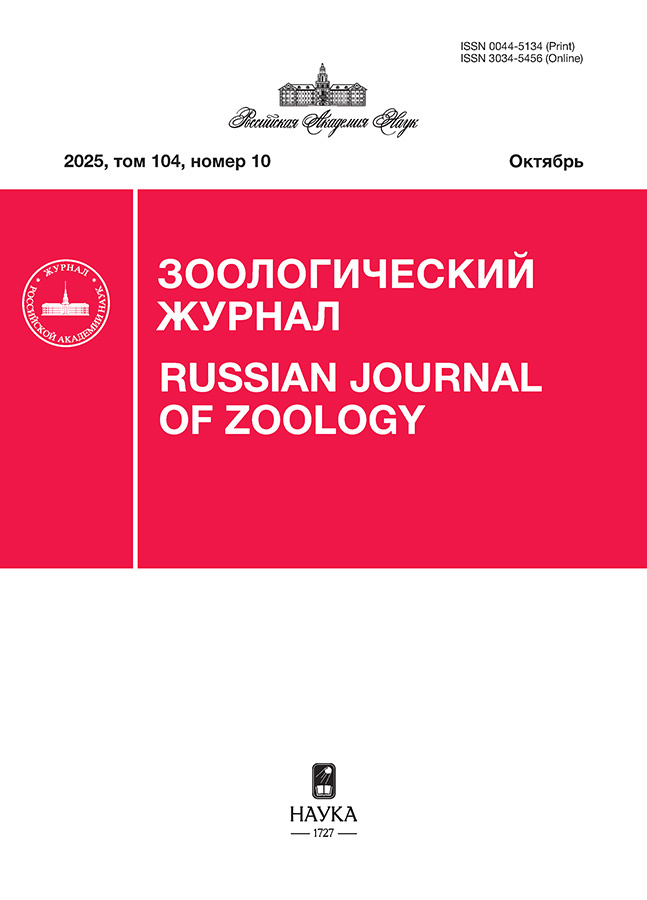ЮВЕНИЛЬНЫЕ СТАДИИ PERGALUMNA EMARGINATA (BANKS, 1895) (ACARI, ORIBATIDA, GALUMNIDAE)
- Авторы: Ермилов С.Г.1
-
Учреждения:
- Тюменский государственный университет, Институт X-BIO
- Выпуск: Том 104, № 10 (2025)
- Страницы: 3-12
- Раздел: Статьи
- URL: https://cardiosomatics.orscience.ru/0044-5134/article/view/696478
- DOI: https://doi.org/10.31857/S0044513425100015
- ID: 696478
Цитировать
Полный текст
Аннотация
Описаны личинка и нимфы панцирного клеща Pergalumna emarginata (Banks, 1895) (Oribatida, Galumnidae). Исследование базируется на орибатологическом материале, собранном на болотах и в сосново-березовых лесах Западной Сибири, Россия. Ювенильные стадии характеризуются следующими морфологическими признаками: рострум острый или узко закругленный; ростральные и ламеллярные щетинки средней длины; межламеллярные и экзоботридиальные щетинки короткие, торчащие; ботридиальная щетинка длинная, ланцетовидная, опушенная; гастронотические поровые поля присутствуют; щетинки гастронотического щита (макросклерита) очень короткие; гастронотическая щетинка c3 длиннее, чем c1 и c2; все гастронотические щетинки имеют склерит у основания; боковая часть тела с несколькими продолговатыми склеритами; медиальная пора присутствует; передний край коксистернума прерван в середине; задняя часть вентральной платы с одной парой больших склеритов; некоторые сегменты ног с толстыми щетинками. Приведены различия между ювенильными стадиями P. emarginata и других известных видов Pergalumna. Даны идентификационные ключи личинок и тритонимф Pergalumna.
Ключевые слова
Об авторах
С. Г. Ермилов
Тюменский государственный университет, Институт X-BIO
Автор, ответственный за переписку.
Email: ermilovacari@yandex.ru
Тюмень, 625003 Россия
Список литературы
- Banks N., 1895. On the Oribatoidea of the United States // Transactions of the American Entomological Society. V. 22. P. 1–16.
- Bayartogtokh B., Ermilov S.G., 2017. Nymphal instars of two Pergalumna species, with remarks on morphological ontogeny of Galumnidae (Acari, Oribatida) // Systematic and Applied Acarology. V. 22. P. 518–540.
- Cooreman J., 1941. Faune des Hautes-fagnes en Belgique (suite et fin) (1). VI (2e partie) Oribatei (Acariens) // Bulletin du Musée royal d’Histoire naturelle de Belgique. V. 17. P. 1–12.
- Ermilov S.G., Sharapov D.V., 2025. Nymphal instars of Pergalumna cienfuegosensis (Acari, Oribatida, Galumnidae) // Persian Journal of Acarology. V. 14. P. 437– 446.
- Ermilov S.G., Khaustov V.A., Mashkov K.A., 2025. Supplementary description of Banksinoma longisetosa Bayartogtokh and Aoki, 1998 (Acari: Oribatida: Thyrisomidae) // Acarina. V. 33. P. 9–16.
- Ermilov S.G., Rybalov L.B., Kuzmicheva E.A., 2024. First record of Malgachebates (Acari, Oribatida, Plasmobatidae) from Ethiopia, with description of a new species based on adult and nymphs // International Journal of Acarology. V. 50. P. 522–529.
- Ermilov S.G., Salavatulin V.M., Khaustov A.A., 2015. The first findings and supplementary description of Pergalumna emarginata (Acari, Oribatida, Galumnidae) from Russia // Acarina. V. 23. P. 121–131.
- Ermilov S.G., Miko L., Kolesnikov V.B., Salavatulin V.M., 2023. Ontogenetic instars of the oribatid mite Spatiodamaeus kalugaensis sp. nov. (Acari, Oribatida, Damaeidae) from Russia // Zootaxa. V. 5324. P. 49–65.
- Grishina L.G., 1977. On morphological features of juvenile instars of Pergalumna nervosa (Berl.) (Acariformes, Oribatei) from Siberia. Taxa of the Siberian Fauna. P. 109–116.
- Jacot A.P., 1935. The species of Zetes (Oribatoidea – Acarina) of the Northeastern United States // Journal of the New York Entomological Society. V. 43. P. 51–95.
- Minor M., Ermilov S.G., Joharchi O., Philippov D.A., 2023. Using Spectral Indices Derived from Remote Sensing Imagery to Represent Arthropod Biodiversity Gradients in a European Sphagnum Peat Bog // Arthropoda. № 1. P. 35–46.
- Nevin F.R., 1978. Additions to the descriptions and classifications of some American galumnids // Acarologia. V. 20. P. 147–158.
- Norton R.A., 1977. A review of F. Grandjean’s system of leg chaetotaxy in the Oribatei (Acari) and its application to the family Damaeidae // In: Dindal D.L., editor. Biology of oribatid mites. Syracuse: SUNY College of Environmental Science and Forestry. P. 33–61.
- Norton R.A., Ermilov S.G., 2014. Catalogue and historical overview of juvenile instars of oribatid mites (Acari: Oribatida) // Zootaxa. V. 3833. P. 1–132.
- Norton R.A., Ermilov S.G., 2024. Catalogue of juvenile instars of oribatid mites (Acari: Oribatida)—the next decade (2014–2023) // Zootaxa. V. 5419. P. 451–494.
- Páez J., Villagomez F., Palacios-Vargas J.G., 2019. Description of a new Pergalumna (Acari: Oribatida: Galumnidae) species from Mexico and its postembryonic development // Zootaxa. V. 4647. P. 385–406.Rockett C.L., Woodring J.P., 1966. Biological investigations on a new species of Ceratozetes and of Pergalumna (Acarina: Cryptostigmata) // Acarologia. V. 8. P. 511–520.
- Sengbusch H.G., 1954. Studies on the life history of three oribatoid mites with observations on other species // Annals of the Entomological Society of Ameri-ca. V. 47. P. 646–667.
- Seniczak S., 1972. Morphology of developmental stages of Pilogalumna tenuiclava (Berl.) and Pergalumna nervosa (Berl.) // Bulletin de la Société des amis des Sciences et des letters de Poznań. V. 12/13. P. 199–211.
- Seniczak S., Iturrondobeitia J.C., Seniczak A., 2012. The ontogeny of morphological traits in three species of Galumnidae (Acari: Oribatida) // International Journal of Acarology. V. 38. P. 612–638.
- Subías L.S., 2022. Listado sistemático, sinonímico y biogeográfico de los ácaros oribátidos (Acariformes: Oribatida) del mundo (excepto fósiles) // Monografías Electrónicas Sociedad Entomológica Aragonesa. № 12. P. 1–538.
- Subías L.S., 2024. Listado sistemático, sinonímico y biogeográfico de los ácaros oribátidos (Acariformes: Oribatida) del mundo (excepto fósiles), 19ª actualización. P. 1–545. Available from: http://bba.bioucm.es/cont/docs/RO_1.pdf (accessed January 2024).
- Travé J., Vachon M., 1975. François Grandjean, 1882–1975 (Notice biographique et bibliographique) // Acarologia. V. 17. P. 1–19.
Дополнительные файлы











